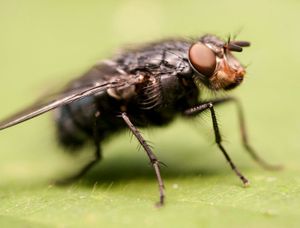
A vast variety of ectoparasites can be found on birds, but they rarely cause primary clinical disease. These infestations are often secondary to another underlying disease or immunosuppression. Patients often coming from crowded, poorly maintained environment or have a history of contact with known infested birds. While often implicated, external parasites are actually a rare cause of feather picking in birds.
Lice:
Lice are wingless insects and the most common of avian ectoparasites. They feed on keratin in the skin and feathers. Their chewing and biting can be irritating. Lice are most often host specific and not pathogenic unless heavy infestation in which feather damage. The presence of lice often are indicative of immunosuppression or poor husbandry.
Mosquitoes (Culicidae) / Gnats (Simulidiae):
Mostly a concern as a vector for diseases such as foul pox or West Nile Virus, problems are otherwise rarely seen in birds.
Flies:
Flat flies or louse flies (Hippoboscids) are blood sucking flies that are not host specific. They can cause anemia in chicks, but their main significance is in spread of blood parasites and transfer of mites and lice between birds.
Fleas:
Fleas in birds in general are not host specific or avian specific. Like fleas in dogs and cats, the majority of their life cycle spent off the host resulting in the build up around nesting sites which may present as skin irritation, restlessness, and blood loss in nestlings. The Sticktight Flea (Echidnophaga gallinacea) is common in tropics and can be seen on imported parrots, raptors, and pigeons, attached firmly around the bird’s head.
Ticks:
Large infestations of ticks can result in debilitation, anemia, and sometimes death. They transmit blood parasites. Birds can have reactions to ticks, most commonly seen with Ixodes frontalis resulting in swelling and bleeding of the face and head.
Mites:
Feather Mites:
These mites are found between barbs and on ventral surface of feathers, seen as dark dots on the feathers. Their entire life cycle occurs on host bird and they are often host specific. They can cause irritation and loss of poultry productivity with high infestations.
Northern Fowl Mite (Ornithonyssus):
These mites are common in poultry and they feed by consuming the blood of their host. They also complete their life cycle on a single host. They typically found around cloaca and maybe on fecal exam from ingestion after preening. These mites can get on other animals and feed on them (rabbits, rodents, gerbils, etc.).
Red Mite/Roost Mite (Dermanyssus):
These mites are also common in poultry. They are nocturnal, often can only be visualized on the host at night as it takes blood meal. Unlike the mites discussed above, these breed off the host in the environment.
Skin Mites:
Epidermoptid Mites:
These are species specific mites for parrots and soft-bills. This burrowing mite causing itchiness, crater lesions, and skin thickening. In canaries they can live live in feather bulbs resulting in congestion and swelling.
Knemidocoptes Mites:
These mites commonly present in budgies and soft-bills such as finches along their nose, legs, and feet. Their presence stimulates marked thickening and crusting of the skin.
Patients present with thickening of the skin of the legs and beak, beak deformities, lethargy, and flaky skin.
Conditions that may appear similar include infection (bacterial, fungal, or viral), feather destructive behavior, nutritional deficiencies, and cancer.
Your veterinarian will perform a skin scraping or sample the affected area with adhesive tape for examination under the microscope. Some larger parasites may be diagnosed with direct visualization. They may also recommend further testing to assure the patient isn’t systemically ill such as a complete blood count and serum biochemistry.
Treatment involves the use of antiparasitic medications specific to the parasite involved. These may be applied topically, orally, as an injection. Often treatment of the environment is necessary to eliminate infestation. Any other underlying conditions should also be addressed.
The prognosis is good in mild infestations with no to minimal concurrent illnesses. However, severe infestations and severe comorbidities carry a guarded prognosis.
It is recommended to recheck at the end of treatment so ensure the infestation has been eradicated.
Copyright © All Rights Reserved
